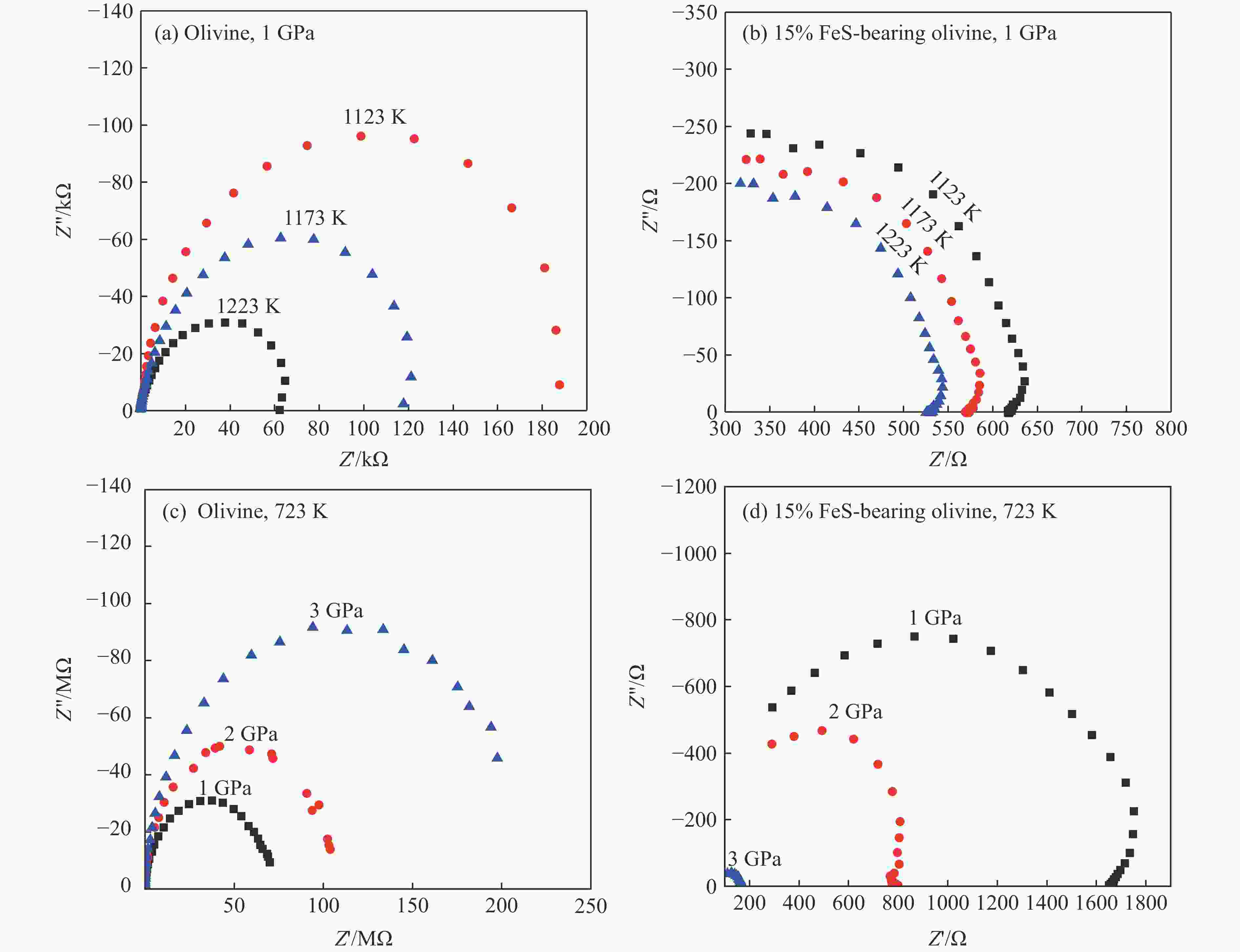Experimental Study on the Effect of Pressure on the Electrical Conductivity of Pure and Iron Sulfide-Bearing Olivine
-
摘要: 在YJ-3000 t紧装式六面顶大腔体压机上,用Solartron-1260阻抗/增益-相位分析仪,在1~3 GPa、723~1273 K的条件下,原位测量了纯的和含15%(质量分数)FeS的橄榄石电导率。实验结果表明:在实验温度范围内,含15% FeS的橄榄石电导率比纯橄榄石的电导率高2~3个数量级,且电导率值在0.1~10 S/m范围内;纯的和含15% FeS的橄榄石电导率都随着温度的增加而增大,但是纯的橄榄石电导率对温度的敏感性更强;纯的和含15% FeS的橄榄石电导率随压力变化表现出相反的特性,随着压力的升高,纯橄榄石电导率微弱地降低,而含15% FeS的橄榄石电导率显著地增加。由含15% FeS的橄榄石电导率对温度、压力的效应以及实验获得的活化焓可知,15% FeS在橄榄石中形成了相互连通的网络,主导着橄榄石的导电过程。Abstract: We performed in situ electrical conductivity measurements on pure and iron FeS-bearing olivine in a multi–anvil apparatus using the impedance spectroscopy technique under the condition of 1–3 GPa and 723–1273 K. The experimental results indicated that the electrical conductivities of 15% (mass fraction) FeS–bearing olivine, in the range of 0.1–10 S/m, are 2 to 3 orders of magnitude higher than that of pure olivine in the experimental temperature range. The electrical conductivities of pure and 15% FeS-bearing olivine increase with increasing temperature. The dependence of the electrical conductivity of pure olivine on temperature is much stronger. The effect of pressure on the electrical conductivity of pure and iron FeS-bearing olivine is different. With the rise of pressure, the electrical conductivity of pure olivine slightly decreases, whereas the electrical conductivity of the 15% FeS-bearing olivine increases significantly. Based on the experimental results including the Arrhenius parameters, it is proposed that the 15% FeS can form an interconnected network in olivine, which dominates the conduction process of olivine.
-
Key words:
- olivine /
- FeS /
- pressure /
- electrical conductivity
-
表 1 样品电导率的Arrhenius关系拟合参数
Table 1. Fitted parameters of Arrhenius relation for the electrical conductivity of samples
Sample p/GPa T/K lg $\sigma_0 $ $\sigma_0 $/(S∙m−1) ${\Delta H}/{\rm{eV}}$ ${\gamma^2}$ 1 723–1273 2.53 338.84 1.18 0.9913 Olivine 2 723–1273 1.96 91.20 1.11 0.9781 3 723–1273 1.05 11.22 1.03 0.9867 1 723–1273 0.47 2.95 0.20 0.9953 FeS-bearing olivine 2 723–1173 1.73 53.70 0.29 0.9802 3 723–1073 2.78 602.56 0.39 0.9845 Note: ${\gamma}^2 $—adjust R-square. -
[1] RINGWOOD A E. Composition and petrology of the Earth’s mantle [M]. New York: McGraw-Hill, 1975. [2] IRIFUNE T, RINGWOOD A E. Phase-transformations in a harzburgite composition to 26 GPa: implication for dynamical behavior of the subducting slab [J]. Earth and Planetary Science Letters, 1987, 86(2/3/4): 365–376. [3] YOSHINO T, WALTER M J, KATSURA T. Core formation in planetesimals triggered by permeable flow [J]. Nature, 2003, 422(6928): 154–157. doi: 10.1038/nature01459 [4] YOSHINO T, WALTER M J, KATSURA T. Connectivity of molten Fe alloy in peridotite based on in situ electrical conductivity measurements:implications for core formation in terrestrial planets [J]. Earth and Planetary Science Letters, 2004, 222(2): 625–643. doi: 10.1016/j.jpgl.2004.03.010 [5] WANG D J, KARATO S I, JIANG Z T. An experimental study of the influence of graphite on the electrical conductivity of olivine aggregates [J]. Geophysical Research Letters, 2013, 40(10): 2028–2032. doi: 10.1002/grl.50471 [6] BAGDASSAROV N, GOLABEK G J, SOLFERINO G, et al. Constraints on the Fe-S melt connectivity in mantle silicates from electrical impedance measurements [J]. Earth and Planetary Science Letters, 2009, 177(3/4): 139–146. [7] WATSON H C, ROBERTS J J, TYBURCZY J A. Effect of conductive impurities on electrical conductivity in polycrystalline olivine [J]. Geophysical Research Letters, 2010, 37: L02302. [8] WATSON H C, ROBERTS J J. Connectivity of core forming melts: experimental constraints from electrical conductivity and X-ray tomography [J]. Physics of the Earth and Planetary Interiors, 2011, 186(3/4): 172–182. [9] ZHANG Z, POMMIER A. Electrical investigation of metal-olivine systems and application to the deep interior of mercury [J]. Journal of Geophysical Research–Planets, 2017, 122(12): 2702–2718. doi: 10.1002/2017JE005390 [10] OMURA K, KURITA K, KUMAZAWA M. Experimental study of pressure dependence of electrical conductivity of olivine at high temperatures [J]. Physics of the Earth and Planetary Interiors, 1989, 57(3/4): 291–303. [11] XU Y S, SHANKLAND T J, DUBA A G. Pressure effect on electrical conductivity of mantle olivine [J]. Physics of the Earth and Planetary Interiors, 2000, 118(1/2): 149–161. [12] DAI L D, KARATO S I. The effect of pressure on the electrical conductivity of olivine under the hydrogen-rich conditions [J]. Physics of the Earth and Planetary Interiors, 2014, 232: 51–56. doi: 10.1016/j.pepi.2014.03.010 [13] DAI L D, HU H Y, LI H P, et al. Influence of temperature, pressure, and oxygen fugacity on the electrical conductivity of dry eclogite and geophysical implications [J]. Geochemistry Geophysics Geosystems, 2016, 17(6): 2394–2407. doi: 10.1002/2016GC006282 [14] HU H Y, DAI L D, LI H P, et al. Influence of dehydration on the electrical conductivity of epidote and implications for high–conductivity anomalies in subduction zones [J]. Journal of Geophysical Research–Solid Earth, 2017, 122(4): 2751–2762. doi: 10.1002/2016JB013767 [15] SHI C Y, ZHANG L, YANG W G, et al. Formation of an interconnected network of iron melt at Earth’s lower mantle conditions [J]. Nature Geosciences, 2013, 6(11): 971–975. doi: 10.1038/ngeo1956 [16] ROBERTS J J, TYBURCZY J A. Impedance spectroscopy of single and polycrystalline olivine: evidence for grain boundary transport [J]. Physics and Chemistry of Miners, 1993, 20(1): 19–26. [17] HIRAGA T, ANDERSON I M, KOHLSTEDT D L. Grain boundaries as reservoirs for incompatible elements in the Earth’s mantle [J]. Nature, 2004, 427(6976): 699–703. doi: 10.1038/nature02259 [18] DAI L D, LI H P, HU H Y, et al. Experimental study of grain boundary electrical conductivities of dry synthetic peridotite under high temperature, high-pressure, and different oxygen fugacity conditions [J]. Journal of Geophysical Research–Solid Earth, 2008, 113(B12): B12211. doi: 10.1029/2008JB005820 [19] TERASAKI H, FROST D J, RUBIE D C, et al. The effect of oxygen and sulphur on the dihedral angle between Fe–O–S melt and silicate minerals at high pressure: implications for Martian core formation [J]. Earth and Planetary Science Letters, 2005, 232(3/4): 379–392. -







 下载:
下载:






